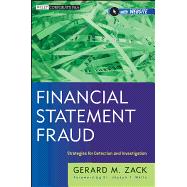
Note: Supplemental materials are not guaranteed with Rental or Used book purchases.
Purchase Benefits
What is included with this book?
GERARD M. ZACK, CFE, CPA, CIA, is a fraud examiner and forensic accountant with more than thirty years of experience performing audits and investigating fraud. In addition to providing antifraud services to clients, he serves on the faculty of the Association of Certified Fraud Examiners, where he conducts antifraud training on financial statement fraud and other topics. He has also spoken at AICPA and IIA events.
Foreword
Preface
Acknowledgments
Part I Revenue-Based Schemes
Chapter 1 Introduction to Revenue-Based Financial Reporting Fraud Schemes
Revenue Recognition Principles
Changes Proposed by FASB and IASB
Overview of Revenue-Based Schemes
Chapter 2 Timing Schemes
Alteration of Records
Shipping Schemes
Percentage of Completion Schemes
Improper Estimates of Revenue Recognition Period
Multiple Element Revenue Recognition Schemes
Customer Loyalty Programs
Channel Stuffing
Bill and Hold Schemes
Sales with Right of Return
Improper Pushing of Current Revenue to Future Periods
Use of Reserves as a ?Rainy Day? Fund
Chapter 3 Fictitious and Inflated Revenue
Fictitious Revenue Schemes
Sales to Related Parties
Inflated Revenue Schemes
Consignment or Financing Arrangements
Chapter 4 Misclassification Schemes
Recording Financing Arrangements as Revenue
One-Time Credits Reported as Revenue
Sales Incentive Schemes
Chapter 5 Gross-Up Schemes
Agent vs. Principal
Barter and Round-Trip Transactions
Phony Revenue and Expenses
Part II Asset-Based Schemes
Chapter 6 Improper Capitalization of Costs
Start-Up Costs
Research and Development Costs
Property and Equipment
Software Development and Acquisition Costs
Website Costs
Intangible Assets
Advertising Costs
Other Deferrals and Prepaid Expenses
Inventory Capitalization Schemes
Inventory Flow Assumptions
Chapter 7 Asset Valuation Schemes
Fictitious Assets
Inventory Valuation Schemes
Inflating the Basis of Property and Equipment
Inflating the Basis of Assets Acquired in Noncash Transactions
Assets Acquired from Related Parties
Understating Depreciation and Amortization Expense
Investment Property
Improper Valuation of Investments ? Financial Assets
Loans
Equity Method Investments
Proportionate Consolidation
Improper Classification or Amortization of Intangible Assets
Impairment Losses ? Nonfinancial Assets
Investments in Insurance Contracts
Chapter 8 Fair Value Accounting
Fair Value Considerations
Methods of Measuring Fair Value
Internal vs. Externally-Developed Valuations
Inputs Used in Measuring Fair Value
Part III Expense and Liability Schemes
Chapter 9 Shifting Expenses to Future Periods
Timing Schemes Involving Liabilities
Accounts Payable
Compensated Absences
Contingent Liabilities
Accrued Compensation
Improper Use of Liability ?Reserves?
Chapter 10 Omissions and Under-Reporting of Liabilities
Debt
Guarantees
Pension Liabilities
Conditional Asset Retirement Obligations
Part IV Other Financial Reporting Schemes
Chapter 11 Consolidations and Business Combinations
Fraudulent Reporting Involving Consolidations
Business Combinations
Chapter 12 Financial Reporting Fraud as a Concealment Tool
Financial Statement Fraud to Conceal Asset Misappropriations
Financial Statement Fraud to Conceal Illegal Acts
Chapter 13 Financial Statement Fraud by Not-for-Profit Organizations
Introduction
Inflating the Value of Non-Cash Contributions
Improperly Reporting Contributions Raised for Others
Netting the Results of Fundraising Events
Improper Allocation of Costs Associated with Joint Activities
Misclassification of Expenses
Chapter 14 Disclosure Fraud
Introduction
Categories of Disclosure Fraud
Common Disclosure Risks
Part V Detection and Investigation
Chapter 15 Detecting Financial Statement Fraud
Introduction
Motives for Financial Statement Fraud
Fraud Risk Indicators
Internal Control Indicators
Chapter 16 Financial Statement Analysis
Use of Analytical Techniques to Detect Fraud
Horizontal Analysis
Vertical Analysis
Budget Variance Analysis
Chapter 17 Ratio Analysis
Research on Ratio Analysis
Use of Operating Ratio Analysis to Detect Financial Statement Fraud
Another Useful Measure: Working Capital to Total Assets
Chapter 18 Other Detection Procedures
Analysis Utilizing Multiple Ratios
Ratios Involving Non-financial Data
Other Information and Disclosures in Financial Statements
Understandability of Financial Statement Disclosures
Testing of Journal Entries
Chapter 19 Fraud or Honest Mistake?
Introduction
The ?Smoking Gun?
Witnesses
Altered Documents
Multiple Records
Destruction of Evidence
Actions That Contradict Recommendations
Patterns of Behavior
Personal Gain
There?s No Other Explanation for It
Chapter 20 Assessing (or Minimizing) Auditor Liability
Introduction
Litigation against Auditors
Concealment from the Auditors
Auditing Standards
Consideration of the Risks of Material Misstatement
Improper or Inadequate Use of Analytical Procedures
Auditing Accounting Estimates and Fair Values
Revenue Recognition Risks
Insufficient Consideration of Related Party Transactions
Auditing Disclosures in the Financial Statements
Over-Reliance on the Management Representation Letter
Appendix Financial Statement Fraud Indicators
Bibliography
About the Author
About the Website
Index
The New copy of this book will include any supplemental materials advertised. Please check the title of the book to determine if it should include any access cards, study guides, lab manuals, CDs, etc.
The Used, Rental and eBook copies of this book are not guaranteed to include any supplemental materials. Typically, only the book itself is included. This is true even if the title states it includes any access cards, study guides, lab manuals, CDs, etc.